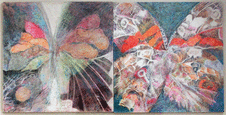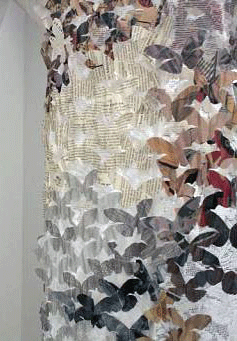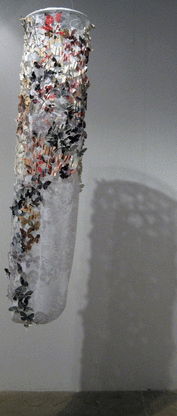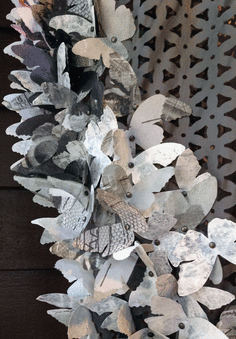
The memory of a first butterfly emerges slowly; as though appearing in the beam of a flashlight that is meticulously searching a dark room. It is a birthday party, about a block from my family-of-origin's flat on Rich Street (which was anything but) in Syracuse, NY, in the 1950s, at night, when I am 7 years old. It is the same party at which I play my first and only game of "spin the bottle." My commercial artist father - they are not referred to as graphic artists in that era - has painted a butterfly, a colorful contemporary version about 8x10 inches. This is the birthday present I bring to the party. The memory elicits dual sensations: pride and embarrassment. His artwork is lovely but handmade, not store-bought. It is poignantly symbolic of our family's talent-laden richness amidst its financial impoverishment.
In the 1970s as I begin to emerge into my own artist identity, my father's butterfly emerges from my subconscious. It serves as a template for visual exploration, as a vehicle to express my own metamorphosis. I watercolor and ink three dozen 18x24-inch butterflies; very few are extant, but I did have the presence of mind to photograph them. A few years ago I transferred the slides to digital format, subsequently spending hours cleaning, via Photoshop, the unwanted specks of dust.
The butterfly literally flutters in and out of my work over the decades. In 2007, it emerges as a subject to be worked in colored pencil, at which time I begin my "100 butterflies" series ("100 butterflies: 4, Night & Day" 2009, above). One wins an award with the Rochester Area Colored Pencil Club, another with the Rochester Contemporary Arts Center. Donation of butterfly artwork to Gilda's Club (a cancer support organization in Rochester, NY, where I volunteered in the art room) becomes my annual signature fundraising gesture.
Exploring the butterfly motif is interrupted by a return to college in 2008-2009 to complete my BS Studio Art. In the world of academia, I dare not consider the butterfly a serious subject. But when I hear "the father of biodiversity" E. O. Wilson speak about the disappearance of butterfly species, I am drawn to the motif yet again. In 2011 I hand-cut hundreds of butterflies the size of a business card, sew them onto suspended fabric, and exhibit this version in two solo shows in Upstate NY. Now I've done it: removed the butterfly from the confines of a sheet of paper, folded it into dimensionality, and set it in motion.
In 2014 I explore yet another medium with the butterfly: laser die-cut shoji paper. Paper is fragile; hand cutting is taxing. Japanese shoji paper is durable and translucent, and die-cutting produces a hundred butterflies efficiently. I attach the butterflies with brads to a 52x16-inch free-rotating suspended cocoon.
However, this year's "new" series pins the butterfly into the two-dimensional realm: collage, ink and paint on a 10x22-inch cradled wood substrate. The image focuses on one wing and only the upper portion, and is oriented vertically. The butterfly is no longer in flight; it is a remnant wing discovered on a path, an exquisite memory once moving in life, yet still moveable in death.
Oh, the butterfly is poignantly symbolic of duality: strong and fragile; immediately recognizable and imminently endangered. Perhaps my relationship with the butterfly is intrinsically linked to richness and impoverishment, but transformed into my present as beauty and ephemerality.
Note: new series featured in the previous blog posting



